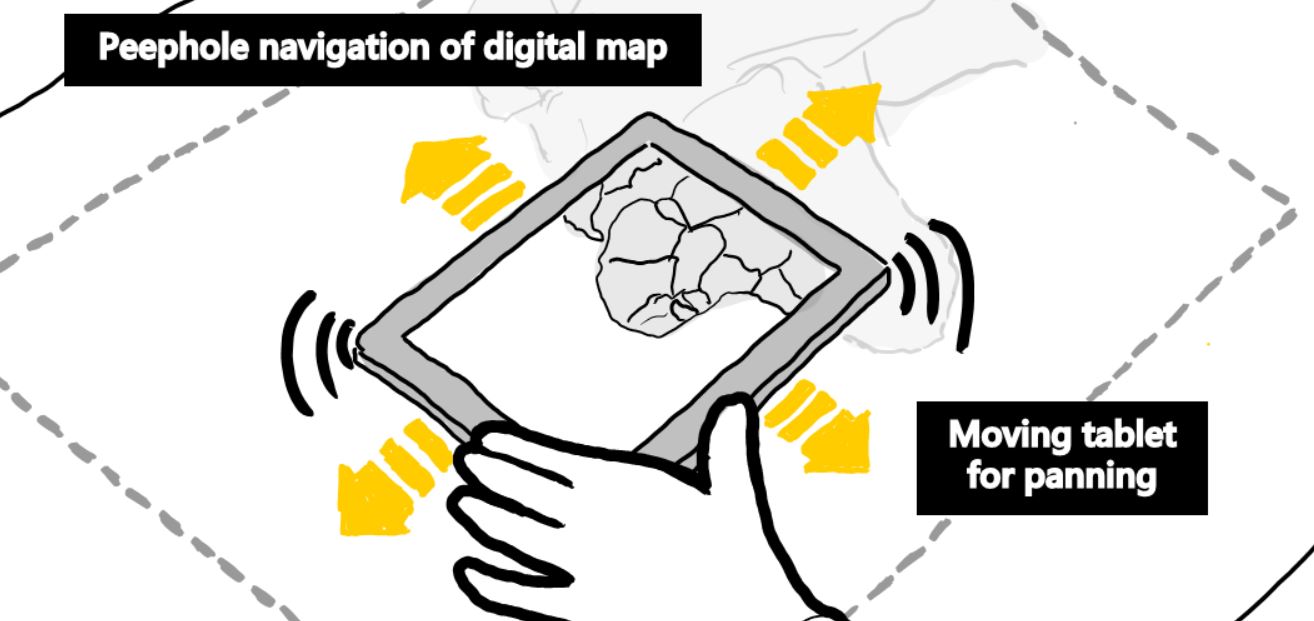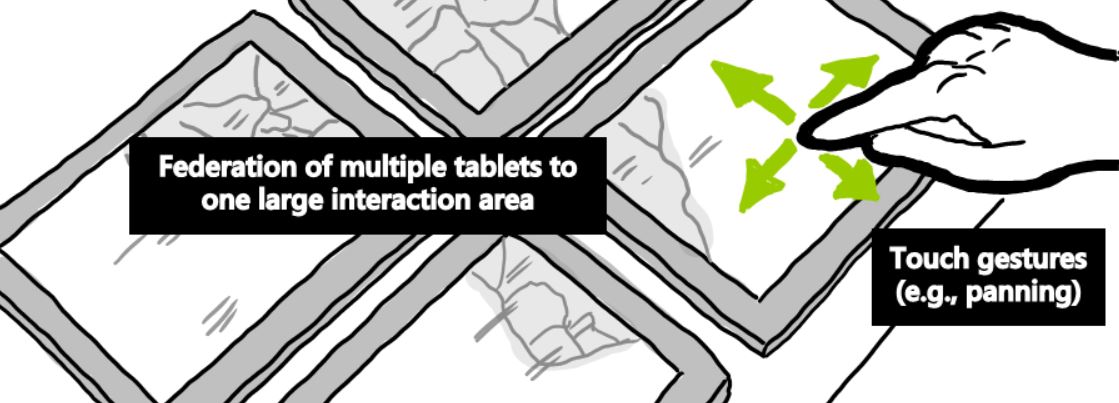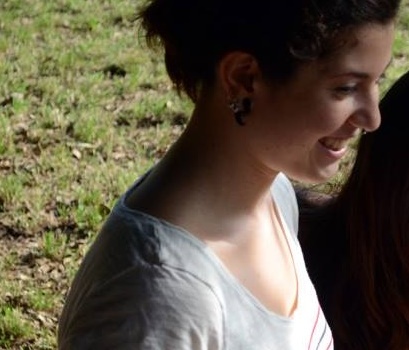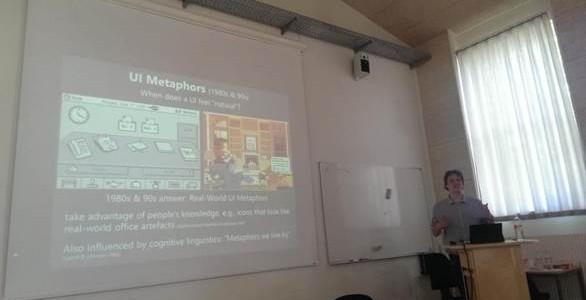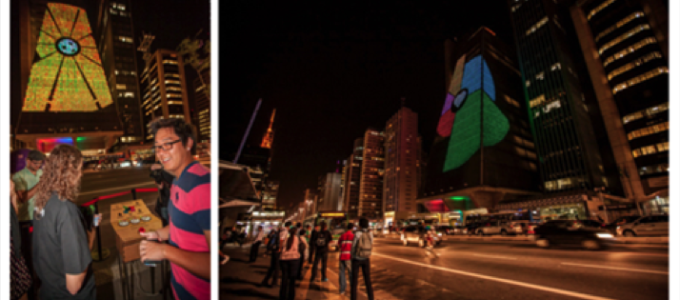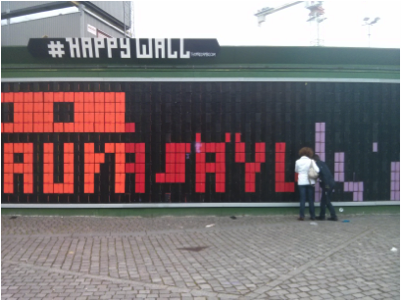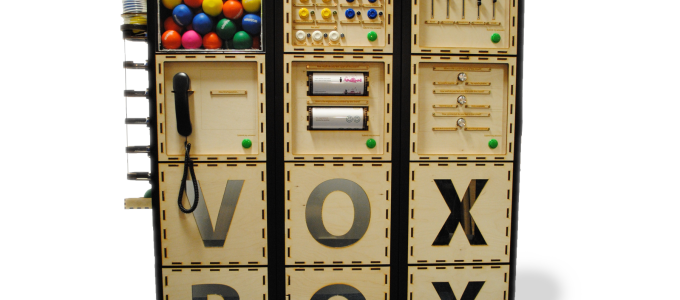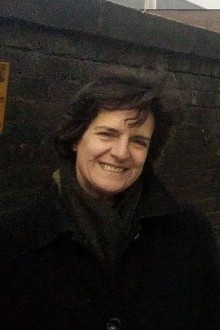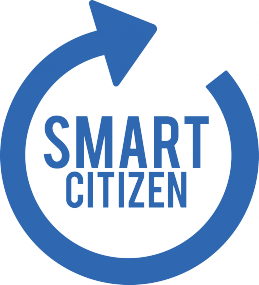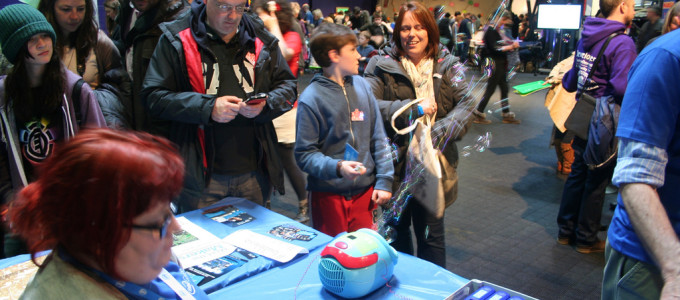We have two Research Associate positions available at ICRI Cities based at UCL. If you are interested in working with us at ICRI Cities, please check out our ‘Work With Us’ page and apply today!
Interactive tables or large displays are great for exploring and interacting with urban data, for example in urban observatories or exhibitions. They turn working with maps, visualizations, or other urban information into a fun and social experience. However, such interactive tables or large displays are also expensive – much too expensive for schools, public libraries, community centres, hobbyists, or bottom up initiatives whose budgets are typically small.
We therefore asked ourselves how we could use the countless tablets and smart phones that are typically idling away in our pockets and bags to compose a low-cost but powerful multi-user and multi-device system from them. How can we enable users to temporarily share their personal devices for creating a joint cross-device system for a social and fun data exploration?
Video of HuddleLamp demo applications
Our result is HuddleLamp, a desk lamp with an integrated low-cost depth camera (e.g. the Creative Senz3d by Intel). It enables users to compose interactive tables (or other multi-device user interfaces) from their tablets and smart phones just by putting them under this desk lamp.
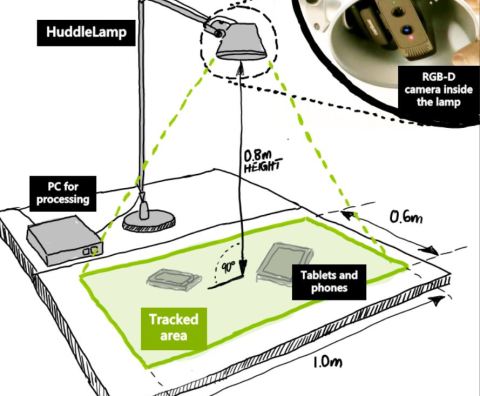
Technical setup of HuddleLamp with an integrated RGB-D camera (Tracking region: 1.0×0.6m).
HuddleLamp uses our free and open source computer vision software to continuously track the presence and positions of devices on a table with sub-centimetre precision. At any time, users can add or remove devices and reconfigure them without the need of installing any apps or attaching markers. Additionally, the users’ hands are tracked to detect interactions above and between devices.
All this information is provided to our free and open source Web API that enables developers to write cross-device Web applications. These applications can use all this information to become “spatially-aware”. This means that the applications can react to how the devices are arranged or moved in space. For example, physically moving a tablet on a desk can also pan and rotate the content of the screen, so that each device appears to be a kind of peephole through which users can view a spatially-situated virtual workspace. When putting multiple tablets or phones side-by-side, these peepholes turn into one huddle or federation of devices and users can interact with them as if they were just one large display.
Peephole navigation and using multiple tablets as one tiled display.
HuddleLamp was created by Hans-Christian Jetter of the Intel ICRI Cities at UCL in London and Roman Rädle of the Human-Computer Interaction Group of the University of Konstanz together with colleagues from the UCL Interaction Centre.
Thanks to the great work of our student research interns Oscar Robinson (UCL), Jonny Manfield (UCL), and Francesco De Gioia (University of Pisa) who visited the ICRI during Summer 2014, we are happy to not only present HuddleLamp in a talk at the ACM ITS Conference 2014 but also to give a live demonstration there.
HuddleLamp is a first step towards a “sharing economy” for excess display and interaction resources in a city. We envision that in future cities users will be able to seamlessly add or remove their devices to or from shared multi-device systems in an ad-hoc fashion without explicit setup or pairing. Instead this will happen implicitly as a by-product of natural use in space, for example, by bringing multiple devices to the same room, placing them side-by-side on a table or desk, and moving them around as needed. Ideally, users will experience these co-located cooperating devices and reconfigurable displays as one seamless and natural user interface for ad-hoc co-located collaboration.
After having created our free and open source base technology, we are now looking at creating and studying examples for the visual exploration of urban data. Our goal is to enable citizens to create their own bottom up urban observatories for community engagement and activism in spaces such as schools, public libraries, community centres, or museums.
Further reading:
To learn how to build your own HuddleLamp and HuddleLamp applications, please visit: http://www.huddlelamp.org or join the HuddleLamp Facebook group.
The ITS paper on HuddleLamp is also available here.
Alessia Romano is currently visiting ICRI Cities as an intern over the summer months. She is based at UCL, working under the supervision of our Senior Research Associate, Dr Sarah Gallacher. We asked her how she is finding the experience and what she is enjoying most about the internship opportunity.
Working for ICRI Cities is a great first experience and opportunity. As a UCL intern I am experiencing how a research team works and learning many new skills. I had the chance to observe and analyse people’s reactions to an already existing project and I am taking part to the birth of a brand-new one.
I find the work environment is peaceful, friendly and cohesive; different kinds of people work in the same room, which makes it possible to get in touch, ask and understand more about each others work. My working hours are flexible and not stressful; you are free to plan your days and tasks. I find that my tutors and colleagues are kind and supportive, they make you feel part of the team and encourage taking part in useful and delightful activities and workshops. I am also having the chance to take part in outdoor events and meet interesting people such as PhD students, PostDocs and researchers.
From Aug 11th to Aug 16th, I was invited to participate and give a 1 hour talk on our conceptual framework of Blended Interaction at the SummerPIT event of Aarhus University in Denmark (http://pit.au.dk/news-events/events/upcoming-events/summerpit-2014/schedule/). This great event was organized by the Centre for Participatory IT (PIT), the Centre for Advanced Visualization and Interaction (CAVI), and the centre of Digital Urban Living (DUL) at Aarhus University.
It was an intense five day programme (more like a small conference with a lot of workshops) starting with very inspiring talks about participation and participatory design for urban spaces and interactions. I particularly liked the talk by Martijn de Waal from the University of Amsterdam about urban imaginaries of the 1950s in Rotterdam (Pendrecht by Lotte Stam-Beese) and the 1960s in London (Plug-in city by Archigram) and what we can learn from their visions of a “republican” vs. “libertarian” city for our future sustainable, connected, and “smart” cities.
My talk was more about concrete problems of interaction design and how the framework of Blended Interaction, which I developed together with my former advisor Harald Reiterer at the University of Konstanz, might help to support design decisions. In particular I described the cognitive mechanisms that can explain when an interaction is perceived as “natural” or “intuitive” by its users or not, similar to our journal article on Blended Interaction from last year (http://link.springer.com/article/10.1007%2Fs00779-013-0725-4). There was a lot of interesting feedback and in-depth discussions about the topic and I am looking forward to follow up activities with my great Danish hosts, Kim Halskov, Susanne Bødker, Peter Dalsgård, Clemens Nylandsted Klokmose, Henrik Korsgaard and many more…
A summary by Moritz Behrens
After having presented a paper [1] at the International Symposium on Pervasive Displays last year, I aimed to approach the research community this year again. At PerDis has always been exciting research presentations with a technical as well as an applied perspective towards pubic displays. In particular I was interested in joining this year’s conference, as media facades seem to become a growing research area within the public display domain.
The 3rd International Symposium on Pervasive Displays (Per Dis) took place at the University of Copenhagen, Denmark during June 3rd and 4th 2014. The conference was organized by Sebastian Boring (General Chair) and Aaron Quigley (Program Chair). Monday evening started with a welcome reception on a boat taking us through the channels of Copenhagen.
The conference kicked off on Tuesday with a keynote by Peter Dalsgaard from Aarhus University. Peter summarised his research on HCI and media facades by presenting identified challenges when designing, deploying and researching interactive urban media installations. He argued that large-scale public displays such as media facades, are a new medium, which researchers are only beginning to understand. Hence new forms of content suiting this medium will need to be explored in more detail. Consequently the development of new techniques and tools to explore the design space frame key aspects of working in this field. At the same time urban places host a variety of situations and practices, which therefore require the design of systems that are flexible enough to accommodate these activities.
With this keynote in mind the presentation of our paper ‘Smart Citizen Sentiment Dashboard: A Case Study Into Media Architectural Interfaces’ [2] at the end of the first paper session fit well into this spirit. We introduced the notion of media architectural interfaces (MAIs), which describe the relation between users engaging with dynamic content on media façades through tangible artifacts on street level. We then illustrated the notion of MAIs through reporting on the technical set up of a field study, in which we deployed a novel tangible user interface (TUI), called the Smart Citizen Sentiment Dashboard (SCSD). This device gives citizens the opportunity to express their mood about local urban challenges. The input from this TUI is then instantly displayed on a very large (3700 sqm) media façade. As a result of this study we identified emergent behavior in the immediate space around the TUI and the wider urban space. We contributed with this paper through highlighting challenges in the design and deployment of large-scale media architectural interfaces. Questions at the end of our presentation were mainly asking if we could measure the impact of our installation on decision-making processes of stakeholders. Unfortunately we had to admit that the deployment period was simply too short for identifying any impact on stakeholders.
Figure 1: Picture from the Smart Citizen Sentiment Dashboard paper.
In the further course of the following paper sessions I will only highlight the once that I consider relevant to my research.
Fabius Seeburger’s paper [3] presentation was about the physical Yes/No buttons, which enable people at a bus stop to ‘Vote With Your Feet’. The system was used as a platform for Local Community Polling on Urban Screens. One aim of this set up was the exploration whether this kind of interface on foot level might lower participation barriers. Fabius found some indications suggesting that participants feel enticed to step on the buttons on foot level.
Another research that has been conducted at QUT in Brisbane, Australia was presented by Markus Rittenbruch [4]. He introduced a framework called CubIT, which is a multi-user, large-scale presentation and collaboration framework. In his paper he applied this framework on the novel interactive display (The Cube) at the new Queensland University of Technology premises in Brisbane, Australia. The studied prototype gave personalized access to the new display through an RFID interface. It allows logging in through participants’ building access cards. As a result challenges of getting access and creating meaningful applications for this particular multi-touch interface were presented.
In this sense Nick Gillian from MIT Media Lab presented an ecology of about 100 networked sensors and 30 public displays across the Media Lab building [5]. The set up gave passers-by the opportunity to access personalized data through facial recognition and browsing their data through gestures.
As these novel possibilities for a more tailored usage of public displays comes with privacy issues such as users feel observed when entering their passwords on public displays, Frederik Brudy demonstrated design methods that make it harder for passers-by to do “shoulder surfing” one’s content [6].
From a more technical perspective this year’s PerDis conference explored ‘Scheduling Interactive and Concurrently Running Applications in Pervasive Display Networks’ [7] or ‘Tandem Browsing Toolkit: Distributed Multi-Display Interfaces with Web Technologies’ [8].
A few projects that were outstanding as they challenged the PerDis community conceptually were the megaphone project by researchers from Montreal [9] and Lisa Koeman’s project [10], who aimed to get “research in the dark” back into day light through turning pavements into chalkboards for community purposes.
At the very end of all paper sessions there was a critical position paper by Simo Hosio [11] who challenged the common assumption of the purpose of public displays and their economic value.
In addition there have been three video presentations of projects, which included ‘The ‘Making of’ MÉGAPHONE, an Interactive “Speakers’ Corner and Digitally-Augmented Agora in Public Space’ as well as the launch of our documentary about the UCL research project: ‘Screens in the Wild: Exploring the Potential of Networked Urban Screens for Communities and Culture’.
In summary, I appreciated the diverse paper sessions and the high quality of the research findings. Overall I got the impression that this year’s PerDis conference was focusing on how to customize access to public displays. In other words, new toolkits and frameworks are have been explored that let user access their private data on a public display. I assume that this might be an attempt to intervene recent observations from UBIOulu researchers who found out that their public Wi-Fi network, which allows people to connect their individual mobile interfaces to the internet, increasingly becomes popular whereas the usage of the embedded public displays (Ubi Hotspots) drops [12].
However, I wished that there had been more discussions around certain topics, as the few minutes of Q&A after each paper presentation was not touching certain topics in depth. In this sense, Simo Hosio’s attack on popular public display assumptions would have enriched a critical view on our work in this field. Panel discussions at the end of each paper session might have been a way to provide this platform. Also the paper sessions could have been more arranged in accordance to the topics of the presented papers.
The demo and poster session, which took place in the evening of the first day, did not quite get the stage they deserved.
Figure 2: Happy Wall
Peripheral activities:
On Monday I gave a talk about my “Screens in the Wild” involvement and current PhD research at the Copenhagen Business School in the Department of IT Management. There is a small research group that aims to explore the smart city from an ethnographical research perspective.
Right after the conference finished, I went to see a talk by Christian Kray from the ‘Institut für Geoinformatik der Universität Münster’ at the Copenhagen Institute of Interaction Design (CIID). Christian presented his recent research about navigation of dense crowds through public displays and a DIY cave (iPED), which allows designers to do rapid prototyping of public displays in urban context. Followed by a tour through the CIID facilities and an introduction to staff and researchers.
Of particular interest in Copenhagen was the recently opened Happy Wall. It is basically an analog low-resolution display, made out of rectangular wooden tiles. On one side the tiles are painted in black. On the inner side they are coloured. Mounted with flexible hinges to a construction wall of a major construction site on a central square in Copenhagen the tiles can be manually flipped by people. Consequently participants were able to create colourful patterns or write names.
References and selection of PerDis publications:
[1] Behrens, M., Fatah gen. Schieck, A, Kostopoulou, E., North, S., Motta, W., Ye, L., Schnädelbach, H. (2013). Exploring the effect of spatial layout on mediated urban interactions. In: (Proceedings), PerDisp’13: The International Symposium on Pervasive Display. ACM library
[2] Behrens, M., Valkanova, N., Brumby, D., Fatah, A. (2014). Smart Citizen Sentiment Dashboard: A Case Study Into Media Architectural Interfaces. In: Proceedings, PerDis’14: The International Symposium on Pervasive Display, Copenhagen, Denmark. ACM library
[3] Steinberger, Fabius, Foth, Marcus, & Alt, Florian (2014) Vote with your feet : local community polling on urban screens. In Third International Symposium on Pervasive Displays, 3-4 June 2014, Copenhagen, Denmark.
[4] Rittenbruch, Markus (2014) Evaluating the use of a very large-scale presentation and collaboration framework. In Proceedings of the 3rd International Symposium on Pervasive Displays, ACM Press and Digital Library, Copenhagen, Denmark.
[5] Gillian, N., Pfenninger, S., Russell, S., Paradiso J. (2014) “Gestures Everywhere: A Multimodal Sensor Fusion and Analysis Framework for Pervasive Displays” in 3rd International Symposium on Pervasive Displays (PerDis’14), Copenhagen, Denmark, June 2014
[6] Brudy, F., Ledo, D., Greenberg, S., Butz, A. (2014) “Is Anyone Looking? Mitigating Shoulder Surfing on Public Displays through Awareness and Protection”
[7] Elhart, I., M. Langheinrich, N. Memarovic, and T. Heikkinen (2014) “Scheduling Interactive and Concurrently Running Applications in Pervasive Display Networks”
[8] Heikkinen, T., J. Goncalves, V. Kostakos, I. Elhart, and T. Ojala (2014) “’Tandem Browsing Toolkit: Distributed Multi-Display Interfaces with Web Technologies”
[9] Fortin, C., Hennessy, K., Sweeney, H. (2014)“Roles of an Interactive Media Façade in a Digital Agora”
[10] Koeman, L., Kalnikaite, V., Rogers, Y., Bird, J. (2014) “What Chalk and Tape Can Tell Us: Lessons Learnt for Next Generation Urban Displays”
[11] Hosio, S., Goncalves, J. , Kukka, H., Chamberlain, A., Malizia, A. (2014)“What’s in it for me: Exploring the Real-World Value Proposition of Pervasive Displays”
[12] Luusua A, Ylipulli J & Ojala T (2013) Situated displays vs. municipal WiFi: Comparing the interactivity of two public infrastructures. CHI 2013 workshop Experiencing Interactivity in Public Spaces (EIPS 2013), Paris, France.
Biography:
Moritz Behrens is an architect and maker, an interaction designer and researcher aiming to combine architecture with human-computer interaction. His work focuses on technology-mediated interactions in urban spaces, which support citizens and communities to engage with social challenges in their city. His recent project aims to design, deploy and research media architectural interfaces that are built on tangible user interfaces as mediators between citizens and interactive media facades. As part of the EU funded “Connecting Cities” network and in collaboration with Nina Valkanova, Moritz has been invited to produce an installation for the Ars Electronica festival later this year.
Currently Moritz is a PhD candidate at UCL The Bartlett in London. Previously he was employed as research associate in the EPSRC funded ‘Screens in the Wild’ project at UCL The Bartlett, which explored networked urban screens for empowering communities.
Moritz has been working as an architect in residential and exhibition projects in Berlin. In London he has been working in different practices as a design consultant for major retail companies. Prior to that he gained a MSc in Adaptive Architecture and Computation from UCL The Bartlett in 2011 and received a masters in architecture from Technical University of Berlin in 2009. Moritz started his career working as a cabinetmaker in the south of Germany.
Monday July 7th sees the Tour De France begin in the UK and make its way across the Channel. Part of the great celebrations of this event will be taking place in London’s Green Park. ICRI Cities UCL team have been working hard on creating an interactive questionnaire box for attendees to get involved in and provide feedback as to how they are feeling and how connected they feel to both the event and one another.
The Vox Box has been created by Sarah Gallacher, Lorna Wall and Connie Goldsteijn of ICRI Cities and members of the public are very welcome to come along and get involved.
As part of our on-going research and collaborations with other Institutions, ICRI Cities at UCL have recently had an exchange visitor from the University of Porto, Paula Trigueiros.
Paula began her career as an architect and even created and ran her own studio. Since 1993 Paula has been a Design Professor at a number of Portuguese universities based in Porto, Lisbon and Coimbra. She studied a Masters in Product Design at the University of Porto and specialized in Inclusive Design. She has written and published a number of studies on architectural and design projects and been a guest speaker at numerous events across the continent, especially related to the theme of Design, Creativity, Accessibility and Inclusion. In 2003 she founded the group PLIM – Free Projects, Ideas in Motion, which is a philanthropic group dedicated to creative exploration of ideas.
Whilst visiting the ICRI Cities centre at UCL Paula engaged with a number of researchers and departments, to further her research. This culminated in a workshop set around the idea of how individuals experience information in an urban environment. set within their own ‘galaxy’. It was well supported by the ICRI Cities UCL members and other individuals from around UCL and provided some great feedback and information for Paula’s on-going work.
Paula has now returned to Portugal, but will be greatly missed around the Centre and we wish her all the very best with her future research and endeavours.
Wednesday 28th May marked the first UK workshop by Smart Citizen at the Manchester Science Park. This workshop saw the kick off of a local community engaged with the development of better tools for citizens to participate in the production of their cities.
The Smart Citizen project uses low-cost sensors to enable people to capture and share data in their local environment, to help understand the effects of urban living on the environment and local citizens. The platform is open to anyone, anywhere and Manchester marks the beginning of a UK community, with two other communities already established in Barcelona and Amsterdam. It is hoped that the data collected and shared can be utilized to help build more sustainable and connected cities in the future.
To find out more about the Future Everything event in Manchester click here.
ICRI Cities have produced a second video in a series of videos highlighting the development of Smart Citizen and this can be watched by clicking on this page here.
A few of our ICRI Cities members attended the recent Maker Faire UK in Newcastle last month. Maker Faire UK is a two day family friendly festival of invention and creativity, bringing together over 300 hackers, crafters, coders, DIYers and garden shed inventors from across the globe – people who love to make stuff and who want to share their passion with the public. Members of our Intel contingent set up a stall to display some of our latest ideas to engage the public with technology and show how sensors in the community work. According to Duncan Wilson, one of the favourite devices they brought along was an inter-active bubble machine, whereby members of the public could send texts to the device, which would then blow out bubbles in response.
You can find out more about Intel’s experience at the Maker Faire UK here.
Duncan Wilson and Greg Jackson discuss air quality sensors in a short video here. These air quality sensors lie at the heart of some of our on-going projects, as the data they provide will help our researchers to find the best solutions to some of the most prominent urban centric problems in relation to future sustainability.
The Maker Faire Paris is due to run on the weekend of the 21st and 22nd June, and looks set to be another wonderful weekend of show, tell and discovery.
ICRI Cities PhD student and co-founder of Smart Citizen, Tomas Diez was in Manchester to mark the launch of the Smart Citizen kits.
The Smart Citizen Kit is an open-source package developed at Fab Lab Barcelona for monitoring the environment in a user-friendly way. The kit comprises 3 technological layers: electronic hardware, an online interface and API, and a mobile app. The goal of the project is to allow anyone to collect environmental data, visualize it, and share it with others with very little hassle.
The hardware used by the Smart Citizen Kit consists of 2 printed-circuit boards: an interchangeable daughterboard or shield, and an Arduino-compatible, data-processing board. The shield included in this version of the kit is dubbed as the Ambient Board. As its name suggests, it carries sensors that measure:
- Air composition (CO and NO2)
- Temperature
- Light intensity
- Sound levels
- Humidity
ICRI Cities have created a short video highlighting Tomas’s work and the exciting prospects this brings for the future of sustainable connected cities, which can be viewed on our ICRI Cities Vimeo site, here.


